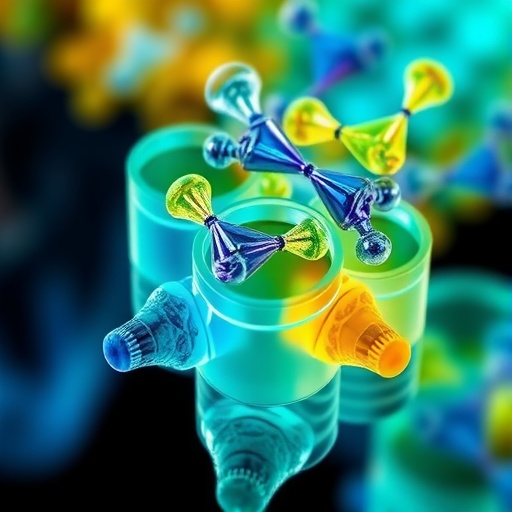In a groundbreaking advancement that bridges natural polymer synthesis and precision chemical engineering, researchers have unveiled a novel catalytic strategy that redefines access to enantiopure poly(3-hydroxyalkanoate)s (PHAs), an important class of biodegradable polyesters. This approach, detailed in a recent publication, exploits the stereochemical richness of bacterial poly[(R)-3-hydroxybutyrate] ((R)-P3HB), turning it into a versatile chiral platform for synthesizing a full spectrum of enantiopure di-isotactic PHAs, opening new avenues for sustainable plastics and advanced materials design.
Natural chiral polymers such as DNA, proteins, and cellulose are almost exclusively found in enantiopure forms, a phenomenon that chemists strive to emulate synthetically. Traditionally, creating enantiopure polymers has depended on enantiospecific polymerizations, utilizing chiral monomers that yield a single stereochemical outcome. However, this traditional framework has long restrained the exploration of diverse stereochemical configurations within polymer backbones, limiting the discovery of novel properties derived from stereochemical variation.
The newly introduced catalytic stereodivergent methodology transcends these limitations by implementing a two-step transformation that begins with harvesting a single chiral polymer, bacterial (R)-P3HB, as a source of chirality. Through precise chemical modifications, researchers convert (R)-P3HB into a suite of enantiopure (R,R)-α-alkylated-β-butyrolactones. These lactones serve as monomers that, depending on the catalytic environment, can undergo ring-opening polymerization (ROP) to yield diverse stereochemical polyesters with unprecedented control.
.adsslot_983aYPAwSn{width:728px !important;height:90px !important;}
@media(max-width:1199px){ .adsslot_983aYPAwSn{width:468px !important;height:60px !important;}
}
@media(max-width:767px){ .adsslot_983aYPAwSn{width:320px !important;height:50px !important;}
}
ADVERTISEMENT
Central to this innovation is the catalyst-controlled diastereodivergent ring-opening polymerization process. When conducted using metal-catalyzed coordination-insertion mechanisms, the polymerization preserves the chiral configuration, producing threo-(R,R)-di-isotactic PHAs. In contrast, when an organic superbase facilitates the anionic ROP, the stereochemistry undergoes inversion leading to erythro-(R,S)-di-isotactic PHAs. This dual pathway enables chemists to select polymer architectures with exacting regio- and stereoregularity, allowing for a detailed dissection of stereochemical effects on polymer behavior.
Elaborating beyond binary stereochemical outcomes, the technique extends to the stereodivergent synthesis of all four possible diastereomeric forms—(R,R), (S,S), (R,S), and (S,R)—of α,α-dialkylated PHAs. Remarkably, these stereoisomers originate from the same (R)-P3HB starting material, a feat that marks a significant departure from the conventional reliance on multiple chiral monomer sources. Such precise stereocontrol offers an extensive palette of polymer configurations poised for systematic evaluation.
An additional facet of this research lies in its cyclic relationship between polymerization and depolymerization. The α,α-dialkylated PHAs synthesized can be depolymerized back to their chiral β-butyrolactone monomers with high stereoselectivity. This recyclability underscores the sustainability potential embedded within the chemical design, with implications for closed-loop polymer lifecycles and environmentally conscious material innovation.
Beyond synthetic mastery, this comprehensive suite of stereocontrolled polyesters facilitates robust investigation into how main-chain stereochemistry and side-chain alkyl substitutions modulate polymer properties. Early analyses reveal nuanced influences on thermal stability, melt processability, and mechanical performance, while stereochemical arrangements dictate the supramolecular organization and stereocomplexation tendencies, critical for material strength and functionality.
This methodology’s potential impact radiates into numerous application arenas. The custom-tailored stereochemistry promises to unlock new classes of biodegradable plastics with tunable physical properties. Additionally, the structural precision achieved here could revolutionize biomedical polymers, where stereochemical fidelity is key to biocompatibility and controlled degradation.
Moreover, the versatility of this approach may inspire innovations in catalysis and green chemistry. Utilizing a naturally abundant polyester as a starting point and achieving full stereochemical diversity through catalyst selection aligns with principles of atom economy and waste minimization, presenting a compelling blueprint for future sustainable polymer syntheses.
The study propels polymer science toward a new paradigm where stereochemistry is no longer a constraint but a design variable. The ability to systematically control regio- and stereoselectivity in polymers paves the way for rational material design informed by stereochemical function, a long-sought objective marrying synthetic precision with material innovation.
In conclusion, the stereodivergent transformation of natural polyesters into enantiopure PHAs epitomizes a milestone in polymer chemistry. By unlocking stereochemical diversity from a single chiral source through catalytic control, this research not only expands the molecular toolbox of polymer scientists but also sets a strategic course toward next-generation sustainable and high-performance materials. The implications for materials science, environmental sustainability, and industrial polymer manufacturing are vast, heralding a future where naturally derived polymers can be custom-engineered with molecular perfection.
Subject of Research:
Catalytic stereodivergent synthesis of enantiopure poly(3-hydroxyalkanoate)s (PHAs) from bacterial poly[(R)-3-hydroxybutyrate] ((R)-P3HB).
Article Title:
Stereodivergent transformation of a natural polyester to enantiopure PHAs.
Article References:
Tian, JJ., Li, R., Quinn, E.C. et al. Stereodivergent transformation of a natural polyester to enantiopure PHAs. Nature (2025). https://doi.org/10.1038/s41586-025-09220-7
Image Credits:
AI Generated
Tags: advanced materials design strategiesbacterial poly[(R)-3-hydroxybutyrate] applicationsbiodegradable polyesters synthesiscatalytic transformation methodologieschiral polymer synthesis techniquesenantiopure poly(3-hydroxyalkanoate)senantiopure polymerization methodsnovel properties of chiral materialsprecision chemical engineering advancementsstereochemical variations in polymersstereodivergent conversion of natural polyesterssustainable plastics development





